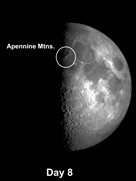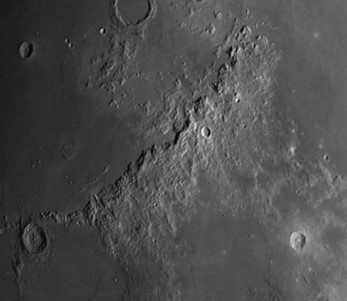The week of March 15-21 takes us from Lunar Day 2 to Day 8. This week we will highlight the Apennine Mountain range, located on the Field Map at [NW/G9] and viewable Sunday evening.
 Montes Apenninus: The Apennine Mountain Range [NW/G9] is the most spectacular feature on the Moon and was formed as a direct result of the impact that created the Imbrium basin nearly four billion years ago. Mountain ranges on the Earth take millions of years to form. The magnificent ranges that surround Mare Imbrium were created in a matter of minutes! They resulted from the shock waves that exploded out from the original Imbrium impact. The Apennines stretch out over 370 miles and include more than 3,000 peaks. The highest peak in this range is Mons Huygens which stretches, from its base to its top, to an incredible 18,000 feet (providing the best skiing in the solar system!)
Montes Apenninus: The Apennine Mountain Range [NW/G9] is the most spectacular feature on the Moon and was formed as a direct result of the impact that created the Imbrium basin nearly four billion years ago. Mountain ranges on the Earth take millions of years to form. The magnificent ranges that surround Mare Imbrium were created in a matter of minutes! They resulted from the shock waves that exploded out from the original Imbrium impact. The Apennines stretch out over 370 miles and include more than 3,000 peaks. The highest peak in this range is Mons Huygens which stretches, from its base to its top, to an incredible 18,000 feet (providing the best skiing in the solar system!)
 Back off and scan the whole area for telltale formations that seem to radiate from the center of Imbrium (don’t forget to check the back side of the Apennines). These radial features resulted from debris that was blown out from the original impact.
Back off and scan the whole area for telltale formations that seem to radiate from the center of Imbrium (don’t forget to check the back side of the Apennines). These radial features resulted from debris that was blown out from the original impact.
======================
It is highly recommended that you get a copy of Sky and Telescope’s Field Map of the Moon, the very finest Moon map available for use at the telescope. It is available for $10.95 at www.skyandtelescope.com and on Amazon. All features mentioned in this blog will be keyed to the grid on the Field Map and will look like this: Plato: [NW/D9]
Credits:
Courtesy of Gray Photography of Corpus Christi, Texas
Lunar photos: NASA / USGS / BMDO / LROC / ASU / DLR / LOLA / Moon Globe. Used by permission
- Hippalus Rilles on the Moon - April 15, 2024
- Moon Crater Janssen: How New Moon Craters are Superimposed on Top of Older Craters - April 8, 2024
- Crater Longomontanus on the Moon - April 1, 2024